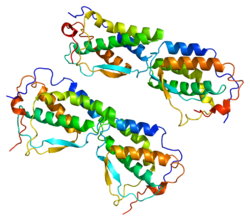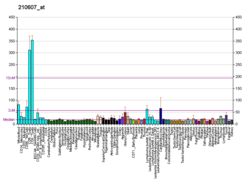Fms-related tyrosine kinase 3 ligand (FLT3LG) is a protein which in humans is encoded by the FLT3LG gene.[5][6][7]
Flt3 ligand (FL) is a hematopoietic four helical bundle cytokine. It is structurally homologous to stem cell factor (SCF) and colony stimulating factor 1 (CSF-1). In synergy with other growth factors, Flt3 ligand stimulates the proliferation and differentiation of various blood cell progenitors. For example, it is a major growth factor stimulating the growth of dendritic cells.[8]
FLT3L functions as a cytokine and growth factor that increases the number of immune cells (lymphocytes (B cells and T cells)) by activating the hematopoietic progenitors. It acts by binding to and activating FLT3 (CD135) which is found on what (in mice) are called multipotent progenitor (MPP) and common lymphoid progenitor (CLP) cells. It also induces the mobilization of the hematopoietic progenitors and stem cells in vivo which may help the system to kill cancer cells.[9]
FLT3L is crucial for steady-state plasmacytoid dendritic cell (pDC) and classical dendritic cell (cDC) development.[9][10] A lack of FLT3L results in low levels of dendritic cells.
- ^ a b c GRCh38: Ensembl release 89: ENSG00000090554 – Ensembl, May 2017
- ^ a b c GRCm38: Ensembl release 89: ENSMUSG00000110206 – Ensembl, May 2017
- ^ "Human PubMed Reference:". National Center for Biotechnology Information, U.S. National Library of Medicine.
- ^ "Mouse PubMed Reference:". National Center for Biotechnology Information, U.S. National Library of Medicine.
- ^ "Entrez Gene: FLT3LG fms-related tyrosine kinase 3 ligand".
- ^ Hannum C, Culpepper J, Campbell D, McClanahan T, Zurawski S, Bazan JF, et al. (April 1994). "Ligand for FLT3/FLK2 receptor tyrosine kinase regulates growth of haematopoietic stem cells and is encoded by variant RNAs". Nature. 368 (6472): 643–648. Bibcode:1994Natur.368..643H. doi:10.1038/368643a0. PMID 8145851. S2CID 4309477.
- ^ Lyman SD, James L, Escobar S, Downey H, de Vries P, Brasel K, et al. (January 1995). "Identification of soluble and membrane-bound isoforms of the murine flt3 ligand generated by alternative splicing of mRNAs". Oncogene. 10 (1): 149–157. PMID 7824267.
- ^ Karsunky H, Merad M, Cozzio A, Weissman IL, Manz MG (July 2003). "Flt3 ligand regulates dendritic cell development from Flt3+ lymphoid and myeloid-committed progenitors to Flt3+ dendritic cells in vivo". The Journal of Experimental Medicine. 198 (2): 305–313. doi:10.1084/jem.20030323. PMC 2194067. PMID 12874263.
- ^ a b Shortman K, Naik SH (January 2007). "Steady-state and inflammatory dendritic-cell development". Nature Reviews. Immunology. 7 (1): 19–30. doi:10.1038/nri1996. PMID 17170756. S2CID 5616725.
- ^ Rahman AH, Aloman C (July 2013). "Dendritic cells and liver fibrosis". Biochimica et Biophysica Acta (BBA) - Molecular Basis of Disease. 1832 (7): 998–1004. doi:10.1016/j.bbadis.2013.01.005. PMC 3641166. PMID 23313573.
© MMXXIII Rich X Search. We shall prevail. All rights reserved. Rich X Search







